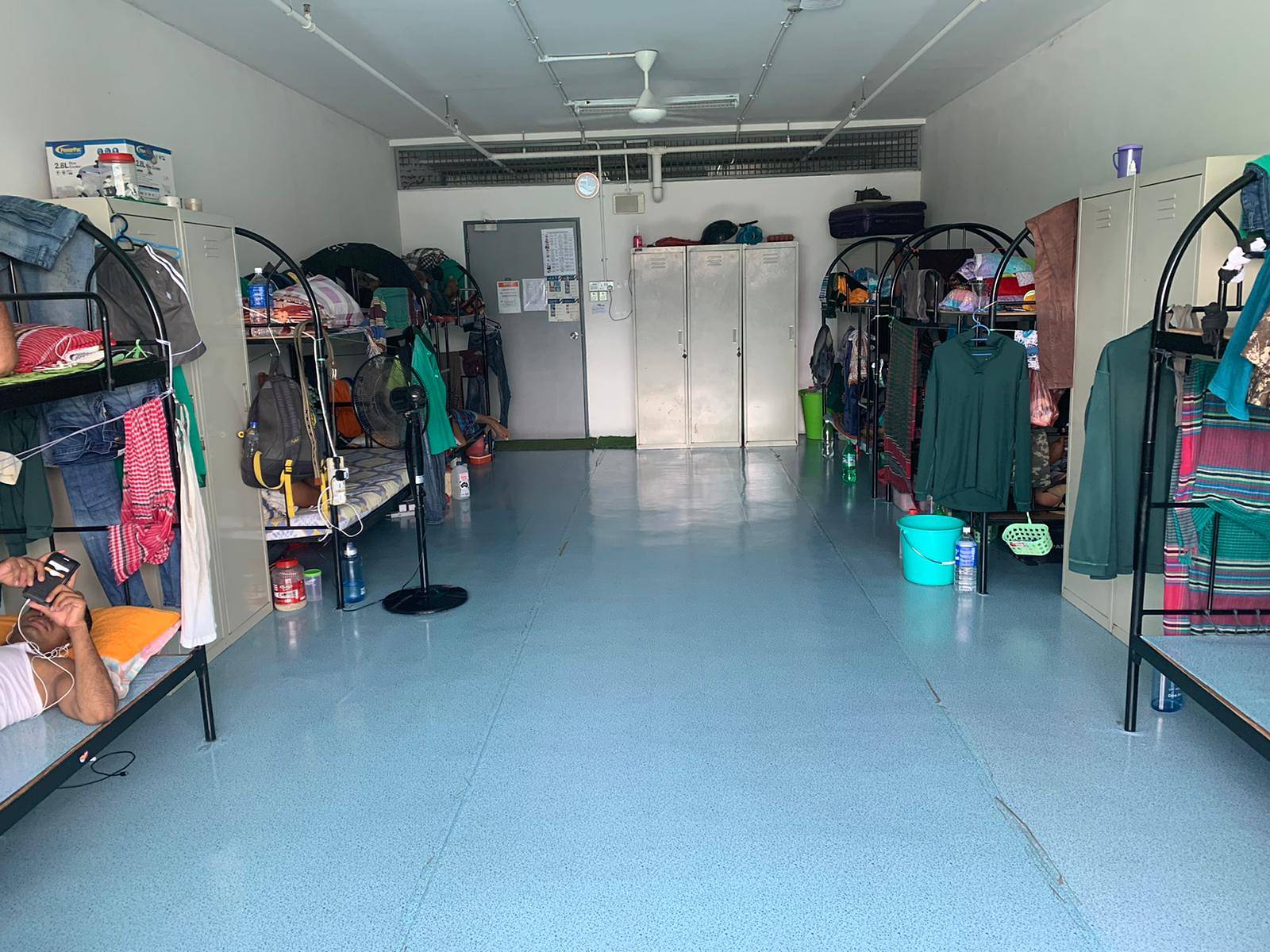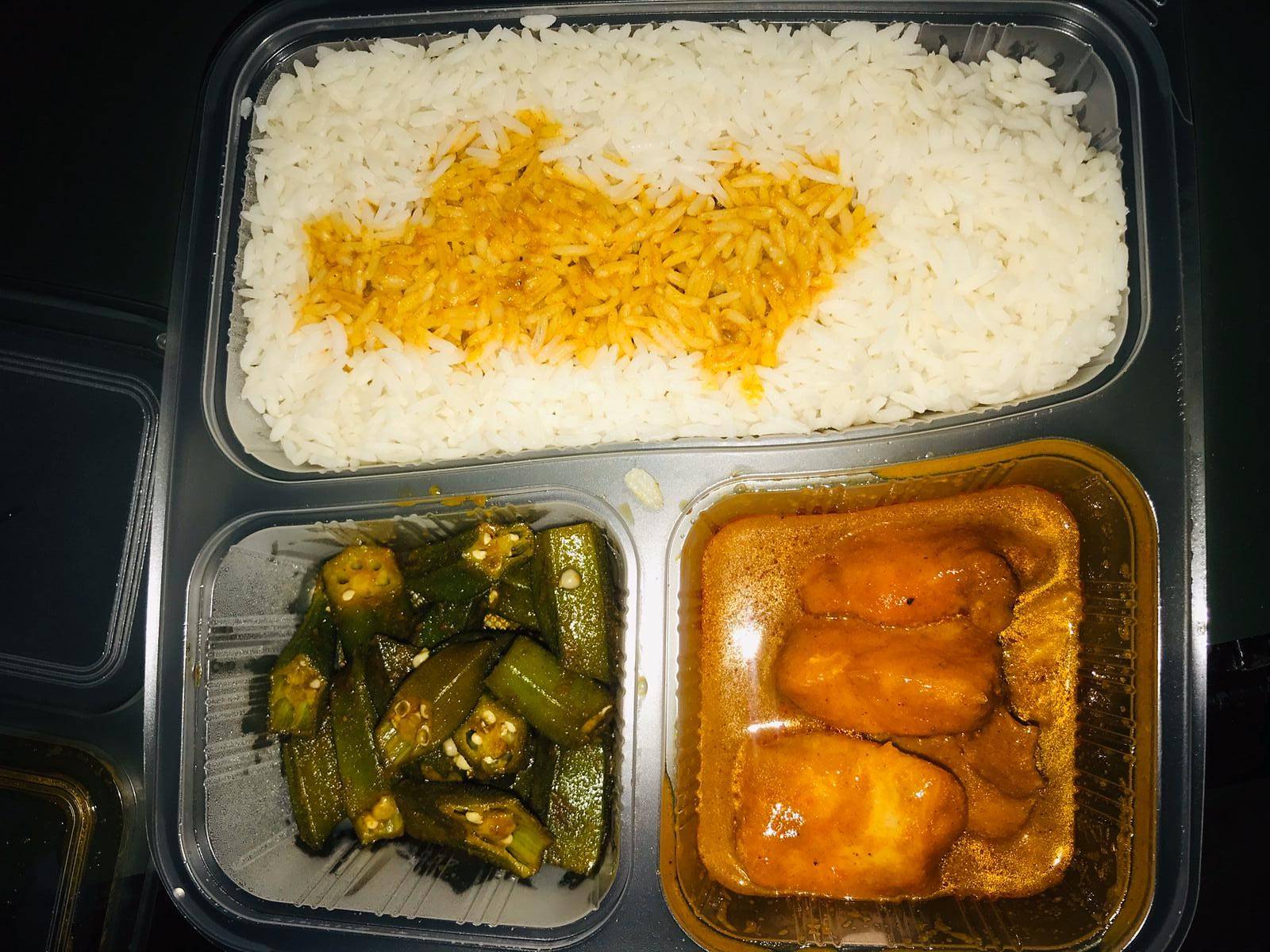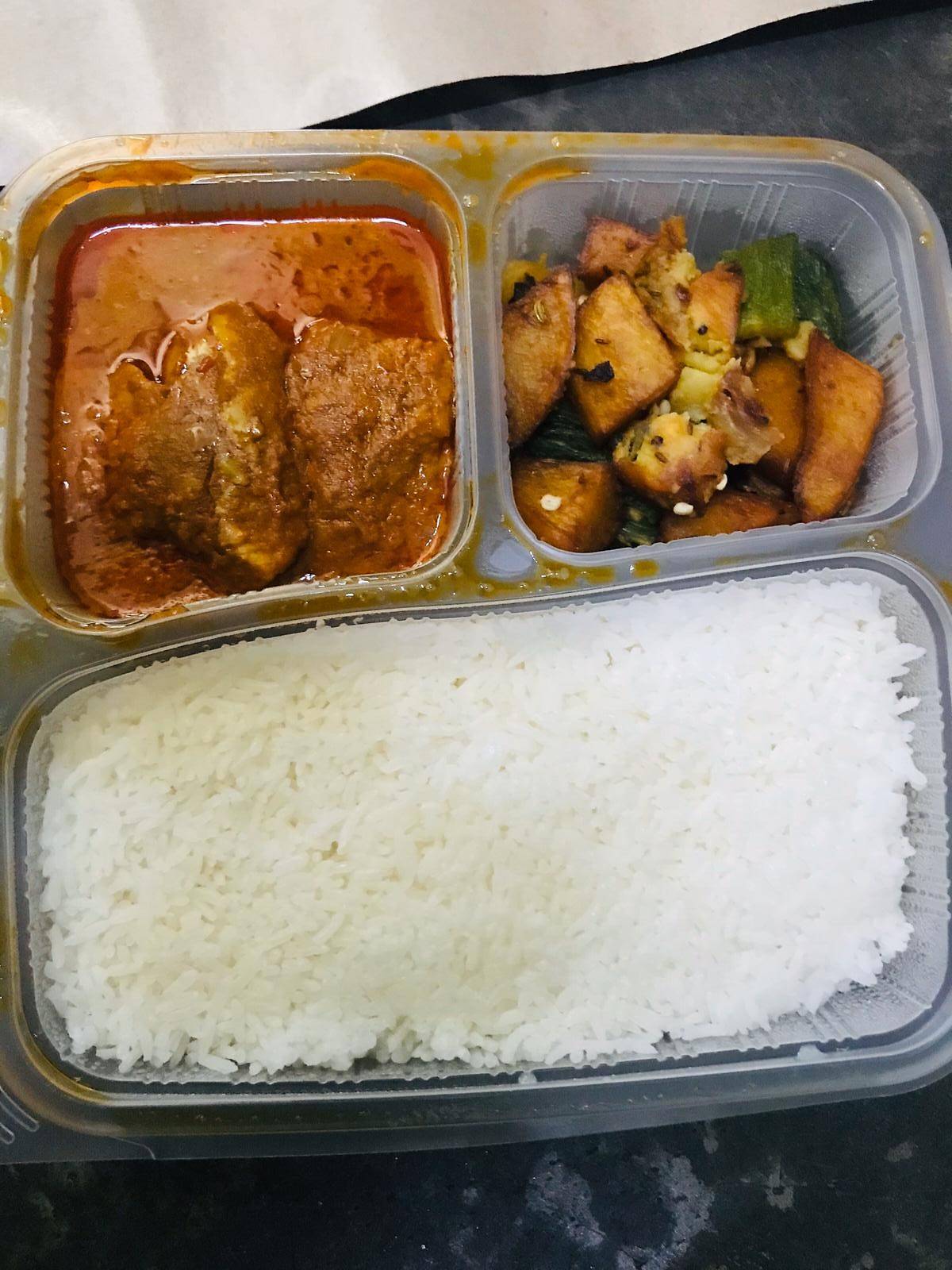SINGAPORE: One by one, over the past week, Ponnu has seen his three room-mates falling sick. Now, he is the only one left in their isolation room.
“I told my wife this. She’s crying on the phone,” said the Indian national who was “scared” that he would be next.
Today should be a happy moment for the couple — it is their fifth wedding anniversary. But the COVID-19 pandemic has clouded the occasion. Ponnu said he just heard that his remaining roommate, who was taken to hospital with a fever on Friday, has tested positive for the virus.
“Last year, I (sent) my wife a card. This year, I can’t send anything. I made her a slideshow with pictures,” the 35-year-old said.
It was just over a week ago when two residents on his floor at the S11 Dormitory @ Punggol were diagnosed with COVID-19. All the workers on that level were moved out and isolated. Ponnu found himself accommodated in a room of four, and his fears have been mounting since then.
Foreign workers stand along the corridor of their rooms in the S11 Dormitory @ Punggol in Singapore on Apr 6, 2020. (Photo: AFP/Roslan Rahman)
For some other foreign workers, the anxiety comes in fleeting moments, amid the slow passage of time under isolation.
At Westlite Toh Guan dormitory, Mohana sometimes worries because he hears that “so many” people outside — referring to the country beyond his dormitory — are infected with COVID-19.
So are a number of his dorm-mates. Two days after the dorm was isolated by the authorities, the worksite supervisor heard ambulances “coming and going”. By noon yesterday (Apr 10), the confirmed cases there totalled 69.
The novel coronavirus (Sars-CoV-2), however, is not the only enemy faced by him and other workers across five dormitories — with a total capacity of nearly 75,000 — now declared isolation areas under the Infectious Diseases Act.
READ: Tampines Dormitory declared isolation area under Infectious Diseases Act
‘THE MIND IS STUCK’
Their fight against boredom is just as real as their underlying fears over their health.
“Everybody feels, the (whole) day, there’s nothing to do,” said Rashif, also from Westlite dorm. “Everybody’s on the phone. Without the phone, everybody has nothing to do.”
Residents at Westlite Toh Guan dormitory. (Photo: Try Sutrisno Foo)
When they had work, they were busy but their minds were “free”. Now, “the mind is totally stuck”, he tried to explain. “Same place, same thing, always continue.”
The situation is similar in the S11 Dormitory, which has a residential capacity of 13,000 and is the heart of Singapore’s biggest COVID-19 cluster, with 306 cases as of Friday.
Mohammed, who lives there, used to wake up at around 5.15am. Now he is awake about 30 minutes later for his morning prayers. “After that, I eat my breakfast. After breakfast, I call my wife,” recited the 35-year-old.
“Around 11am, we clean our room, then shower again and pray around 1.30pm. After that, we eat our lunch — the whole day inside our room.”
Residents at Sungei Tengah Lodge waiting for their isolation to end. (Source: ‘Pangkil’)
That was his routine the first time CNA Insider spoke to him via Zoom on his phone on Tuesday, to track how life has been inside these dormitories over the course of the week.
It was the same routine the next day, and by Friday, he could not stand being in his room any more. He admitted to sneaking out for a short while below his block within the compound, just to break into a run for exercise.
“But I first checked if, outside, the police (were there) or not,” he said with a nervous laugh.
Some of the workers get to stretch their legs along the dormitory corridors, as their rooms have no en suite toilet facilities.
But the thing about that is, according to Mohammed, there is only one shower or toilet cubicle for every 18 people, or more, in a time of safe distancing.
A worker disinfects a toilet at Toh Guan Dormitory, the third dormitory to be declared an isolation area. (Photo: Ministry of Manpower)
IMPROVING CONDITIONS
The workers’ living conditions have come under the spotlight since the first two dormitories were gazetted on Sunday. One report in The Straits Times spoke to cockroaches and unsanitary conditions on the premises.
READ: Crowding, emotional health of migrant workers at dormitories concern employers
Led by an inter-agency task force, however, the cleanliness and sanitation conditions at the dormitories “have vastly improved as enhanced measures and cleaning routines are put in place”, the Manpower Ministry said on Friday.
Prime Minister Lee Hsien Loong spoke of the work being done in the dormitories in his latest address to the nation on the COVID-19 situation.
READ: Cleanliness and sanitation at 4 isolated foreign worker dormitories ‘vastly improved’: MOM
READ: Singapore is paying ‘close attention’ to welfare of foreign workers amid COVID-19 outbreak: PM Lee
“We’re paying close attention to the welfare of the foreign workers. They came to Singapore to work hard for a living, and provide for their families back home. They’ve played an important part building our HDB flats, Changi Airport, MRT lines,” he said on Friday.
“We’ve worked with their employers to make sure they’ll be paid their salaries, and can remit money home. We’ll provide them with the medical care and treatment that they need.
“If any of their family members watch my video, let me say this to them: We appreciate the work and contributions of your sons, fathers, husbands in Singapore. We feel responsible for their well-being. We’ll do our best to take care of their health, livelihood and welfare.”
Among the workers — mostly from Bangladesh — that CNA Insider spoke to over the phone and via video-conferencing, their rooms look clean.
But “people make it dirty very fast, because so many people live together”, said Pangkil at Sungei Tengah Lodge, one of the other gazetted dormitories. Pangkil’s name, and those of some residents in this story, have been changed at their request.
“Sometimes I’m very worried because we live with 12 people together — can’t really be one metre apart. I’m worried that the virus will spread.”

A room at Sungei Tengah Lodge. (Source: ‘Pangkil’)
Space may be taken up by items such as buckets and cooking utensils. And then there are the double-decker beds, which are “very close” to one another, Rashif pointed out to CNA Insider with his phone.
“If he (lies) here (on one bed), then (he can) touch another person over here (on another bed). It’s not one metre also, but for us, (there’s) no choice,” said the 26-year-old.
Plans are underway to relocate thousands of healthy workers from various dormitories to alternative facilities. Already, more than 5,000 of them in essential services have moved to sites like Singapore Armed Forces camps. From next week, they will also be housed at two floating accommodations.
READ: ‘Dedicated strategy’ to break Covid-19 spread in dormitories, including housing healthy workers in army camps
As of Saturday, the residents contacted by CNA Insider have not seen an impact in the number of people in their own quarters. They are unaware of the situation beyond their own floor.

Rashif points out living arrangements in Westlite Toh Guan.
The workers are aware of the need for personal responsibility, although Pangkil is worried because “we don’t know if someone has any symptoms if they … think it’s normal”.
Rashif’s room-mates have him, a workplace safety and health co-ordinator, to help ensure that their temperatures are taken daily.
If anyone’s reading is on the high side, he gets them to hydrate themselves before doing another check 10 minutes later. If the reading does not come down, “then we report”, he said.
KEEPING UP WITH DEVELOPMENTS
He and his roommates received their masks, thermometers and hand sanitisers the day after their isolation began. “They told us before that it was challenging (to give them out earlier) because there are so many people,” he said.
The packet from the Ministry of Manpower that Rashif received.
More support measures have since been put in place in the dormitories, and these include logistics, as well as healthcare provision by the SAF Army Medical Services.
But other than seeing the cleaning and disinfection of common areas being stepped up — to an average of three times a day, according to MOM — residents like Rashif say they are not clued in to some of these moves on the ground.
Residents say they were also taken by surprise when their dormitories were first gazetted as isolation areas. Some of them heard it on the news before they saw ministry officials and police officers in their compounds.
At the Westlite dormitory, the announcement over the PA system came late at night. “Most of the people were going to sleep, or some slept already. Then after (it was) announced, they woke up,” recounted Rashif, whose block was isolated first.
This was followed by notices being given to every room. “They just (said) stay in the room … and all maintain a one-metre distance. Then clean yourself — personal hygiene,” he cited.
The stay-home notice given out in Rashif’s block.
When Sungei Tengah Lodge was gazetted on Wednesday, ennui turned to deeper worries among some workers like Pangkil. “Because I saw in the (previous) two days, more than 15 ambulances arrived. I don’t know what’s next,” said the 23-year-old.
The atmosphere there has since become surreal. “Everywhere is silent,” he described. “I feel stressed, but I can accept it. Because I think that’s how animals — birds — stay in enclosed houses (cages) for a long time.”
The workers are not, however, totally cut off from the rest of Singapore: They have been using chat tools, video platforms especially TikTok, and other social media to share news, and not just in the declared isolation areas.
On Thursday night, for example, there was a live-stream on the Migrant Workers Singapore Facebook community page. Hosted by one of the residents, and hampered by patchy Internet connections, participants from various dorms across Singapore shared about how they were coping.
Foreign workers stand along the corridor of their rooms in the S11 Dormitory @ Punggol on Apr 6. (Photo: AFP/Roslan Rahman)
THEY’RE NOT ALONE
Migrant worker welfare groups are also working overtime to assist the workers. Project Chulia Street, for example, is providing care packages with hygiene products such as soap, shampoo, toothbrush, toothpaste and masks, said its managing director Lee Shaun Tzen.
As of Friday morning, with donations pouring in, the group had manged to raise S$330,000 to help some 43,000 workers.
A coalition of four groups — Citizen Adventures, Singapore Migrant Friends, ItsRainingRaincoats and MigrantxMe — is planning an online learning portal for the workers where Singaporeans can volunteer to share lessons, from languages to the arts.
READ: NGOs launch initiatives to help migrant workers amid COVID-19 outbreak
The group SDI Academy is even coming up with a mental health app on Android, called Linger.AI, by the end of the week. Besides health resources, it will also offer English lessons and a module on entrepreneurship.
Explaining the reason for such initiatives, Citizen Adventures director Cai Yinzhou said: “(On) day two, people are happy with sitting (and) watching (their phones), but … by day five or six, how many videos can you watch?
“People start getting restless. There’s really nowhere else they can go, unless things change.”
Foreign workers having their meals in their rooms at Toh Guan dormitory, which is under isolation. (Photo: Ministry of Manpower)
Some of the groups including the Humanitarian Organisation For Migration Economics (HOME) are raising funds, in anticipation that “many workers will experience financial crises raised by COVID-19”, said HOME casework executive Desiree Leong.
A spreadsheet which consolidates all these groups’ efforts, with information on how the public can chip in, has been circulated and has drawn encouraging response.
Some of the workers’ needs, however, have been as simple as getting the right food.

Rashif’s dinner on Tuesday. (Source: ‘Rashif’)
“On the first day, they had food (catered), but it’s not to their liking, and the portions were quite small,” cited human resource manager Tabitha Lim from Jerevin Industrial, which has workers in one of the gazetted dormitories.
“In the group chat, there are also other business owners who mentioned that their workers were given Chinese food, which they can’t eat because some of them are Muslim.”
This is one of the things the task force has been trying to improve. The Manpower Ministry said on Thursday that the caterers have “implemented new measures to ensure timeliness in the distribution of food and quality of the food”.
For example, at Westlite Toh Guan, which has close to 6,700 occupants, the meals now take 90 minutes to be fully distributed, instead of two hours, according to dormitory manager K Dave.
“We also increased manpower, together with the Migrant Workers’ Centre assisting on this part,” he said. “My staff and I are also consuming the same food.”

Rashif’s lunch on Thursday. (Source: ‘Rashif’)
Asked about his lunch on Thursday, Rashif said via text that it was “50/50”, followed by a disappointed-face emoji.
He also now hears of more workers being taken to hospital. “Very worried,” he texted.
Amin, a resident at S11 who has worked in Singapore for six years, cannot help but feel that the coronavirus “is coming” to the rooms on his floor. And when he called his mother yesterday, he broke down, he said.
“All men are scared,” the 25-year-old told CNA Insider. “(Going to toilet) is also scary; every place is also scary. Boredom is no problem. Movies (we) can see, but I’m scared (in terms of) a mentality problem. Tension comes, headache comes.”
Check out this spreadsheet of the efforts to help Singapore’s migrant community to see how you can contribute.
A room being disinfected at the Westlite Toh Guan Dormitory on Apr 10, 2020. (Photo: Ministry of Manpower)




